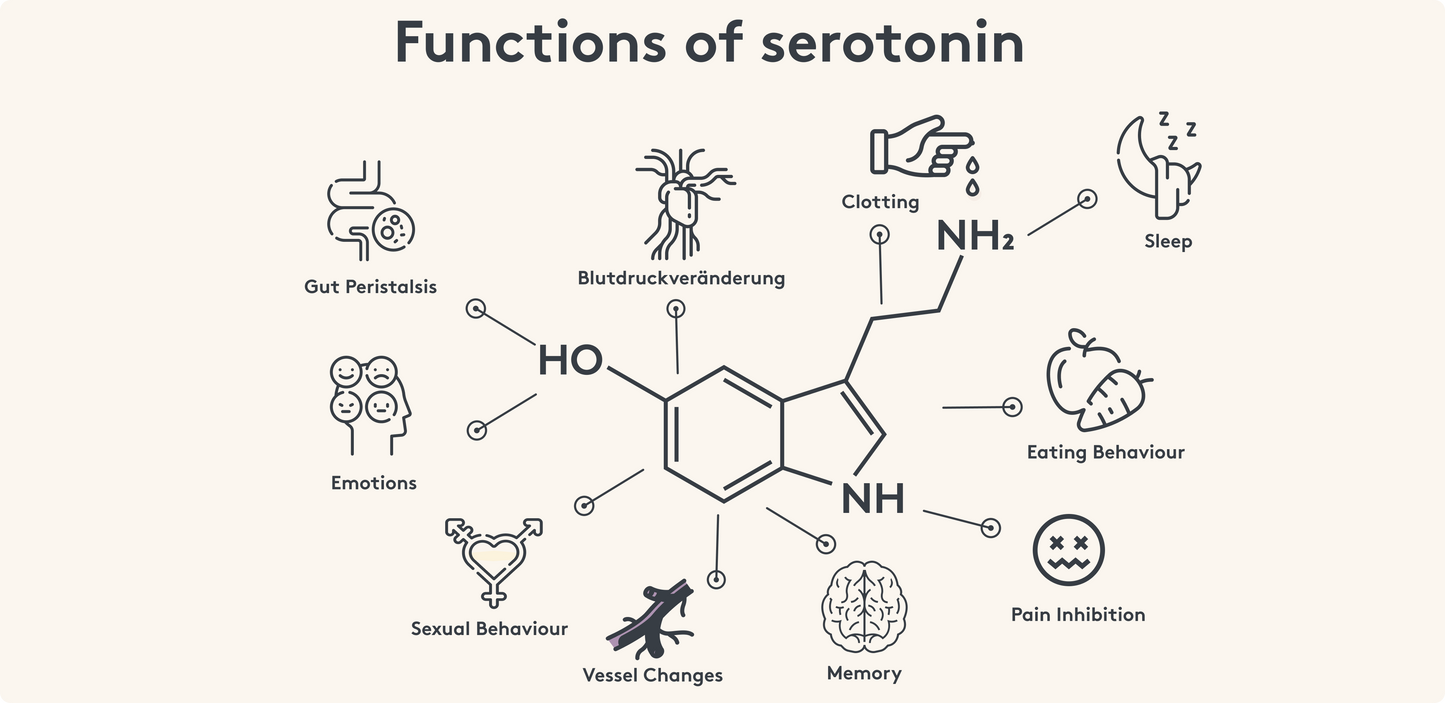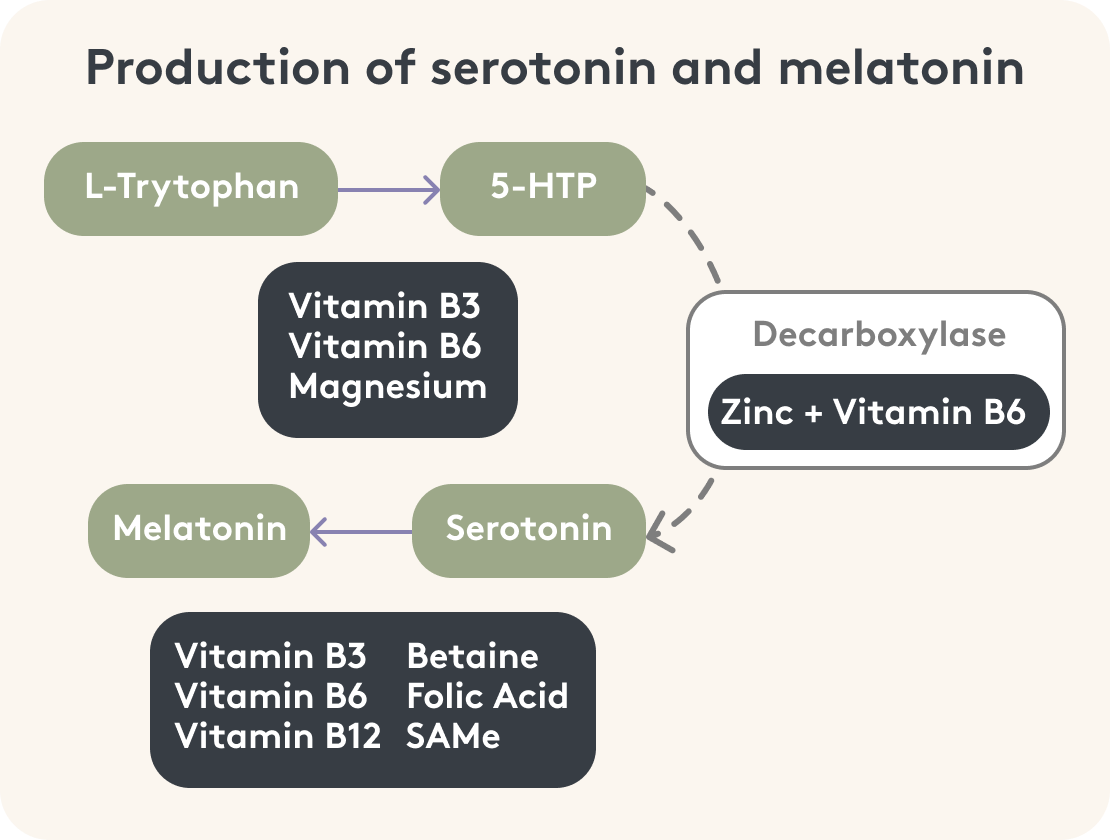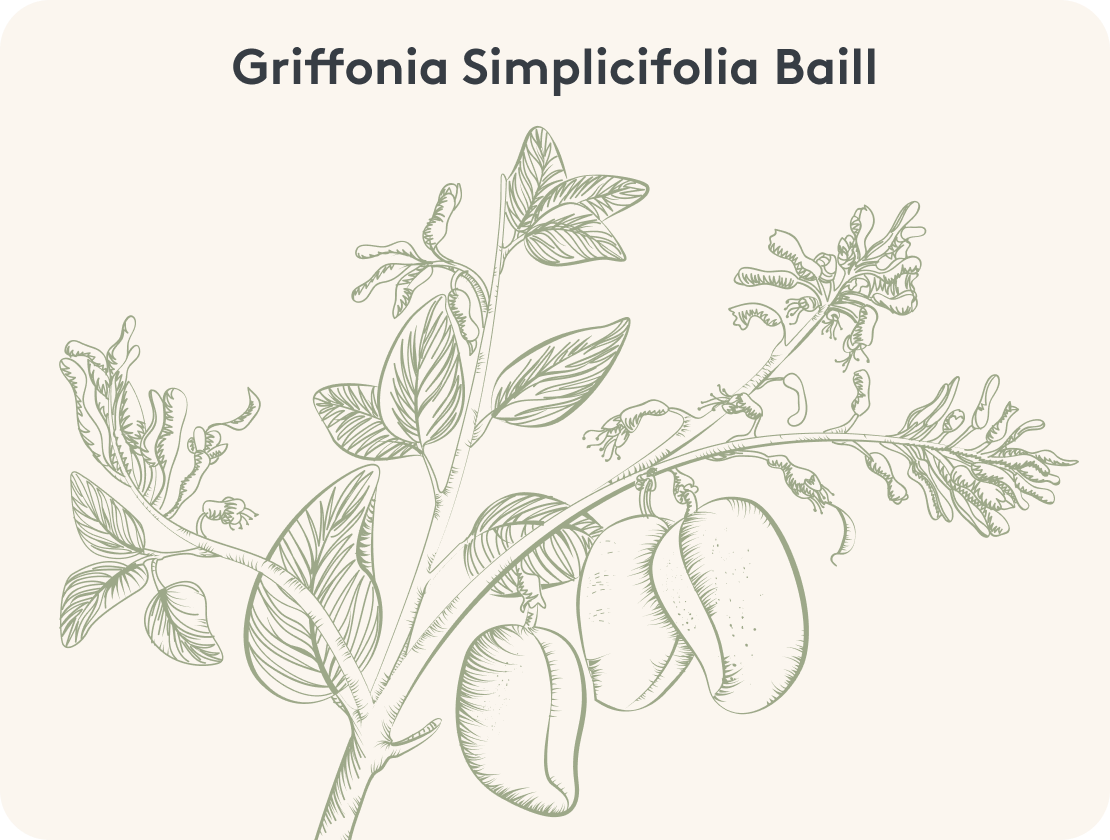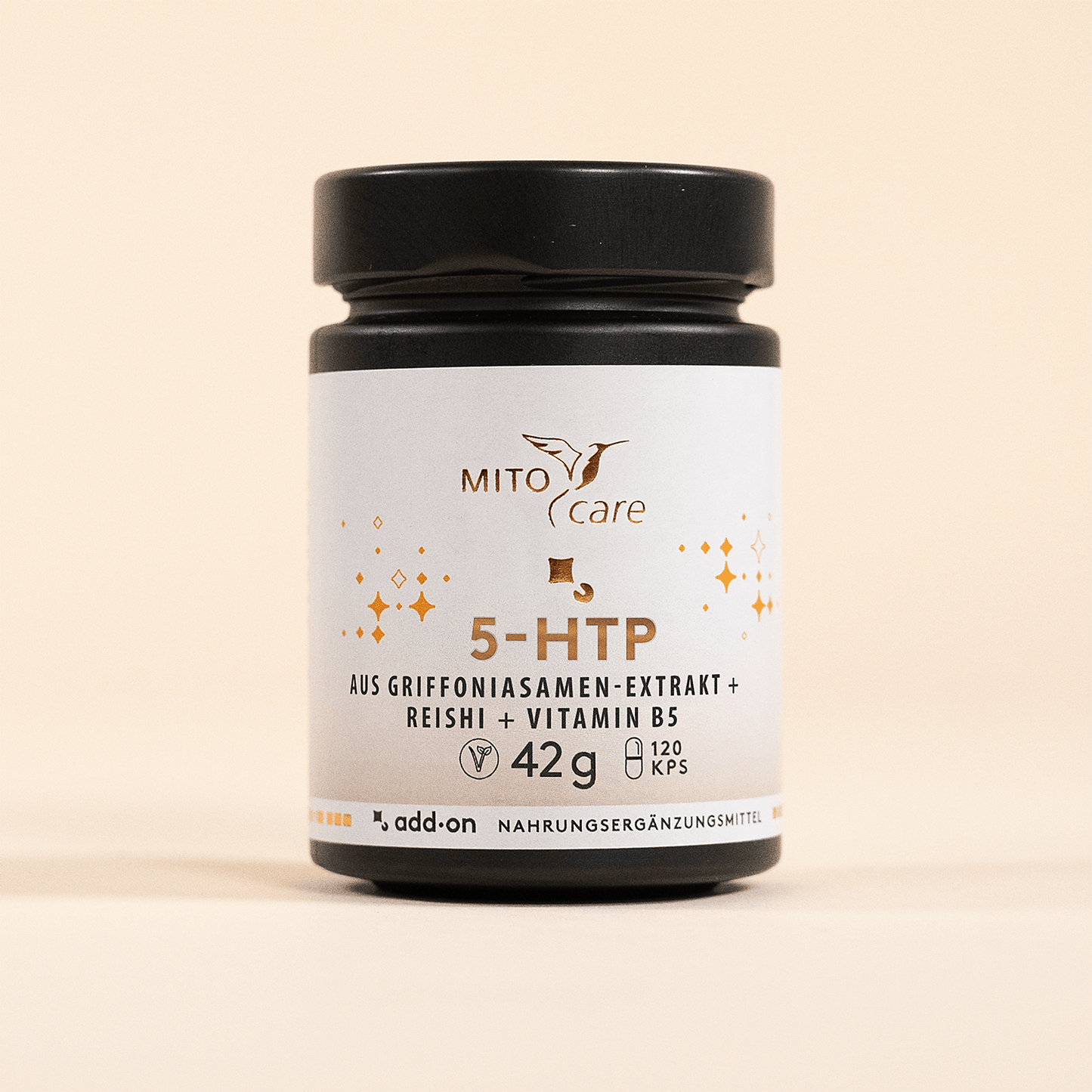Themen dieses Blogartikels:
Table of Contents
- Definition: What is serotonin?
- Effect: The most important functions of serotonin
- What is 5-HTP & how is the precursor of serotonin created?
- Effect: What does 5-HTP do in the body?
- The Role of 5-HTP for Serotonin Levels
- Where does the body get 5-HTP?
- Is it permissible to take 5-HTP as a dietary supplement?
- How to convert more L-tryptophan into 5-HTP?
- Important to know when taking tryptophan
- Sources & Bibliography
Definition: What is serotonin?
Serotonin is a hormone and a neurotransmitter: it transmits stimuli from nerve cell to nerve cell. 90% of serotonin production takes place in the intestine, from where the hormone, also known as the happiness hormone, enters the blood and is stored by the platelets and blood cells.
However, the finished hormone cannot travel from the blood to the brain because it is unable to cross the blood-brain barrier. However, as a neurotransmitter, it must be present in the central nervous system, so the hormone must be produced separately there. This occurs primarily in the raphe nuclei, the core areas in the brain stem.
Effect: The most important functions of serotonin
The neurotransmitter serotonin has an effect wherever a corresponding receptor is found. It not only ensures a good mood and restful sleep, but also takes on the following functions in the brain and spinal cord:
- Promotes pain inhibition
- Supports thermoregulation to protect against cold or fever; it probably contributes to the development of fever as a result of the infection¹
- Influences the coding and content of memories with its receptor 5-HTP²
- As a precursor to the sleep hormone melatonin, it contributes to the regulation of the sleep-wake rhythm
- Can influence eating behavior; after meals that are particularly rich in carbohydrates, more serotonin is produced at the synapses, while when fasting, more of it remains in the synoptic cleft and can therefore have a longer effect³ – the hormone therefore indirectly influences eating behavior by controlling our mood
- Regulates sexual behavior and primarily has an inhibitory effect⁴, while other neurotransmitters such as dopamine have an activating effect
- Controls emotional processes
Serotonin is also important outside the cells of the nervous system. Here it has the following main functions:
- Can cause narrowing of blood vessels in the lungs (vasoconstriction)⁵
- Can alter blood pressure and in the long term lead to hypotension, i.e. lower blood pressure⁶
- Plays a role in blood clotting; it increases platelet activity and can cause vasoconstriction at the injured site⁷
- Influences intestinal peristalsis and can stimulate intestinal muscles and digestion


What is 5-HTP & how is the precursor of serotonin created?
The neurotransmitter serotonin is not simply available in the body; it must first be produced. Several intermediate steps are necessary for its production. The starting material for the synthesis is the amino acid L-tryptophan , the direct precursor is the amino acid 5-hydroxytryptophan (5-HTP).
This is how the conversion of L-tryptophan to the intermediate 5-HTP and serotonin and finally to melatonin works:
- An enzyme converts tryptophan in the liver into 5-HTP, a precursor of serotonin. Important co-factors in the reaction are vitamin B3 , vitamin B6 and magnesium .
- The 5-HTP can now react further. While only a small amount of the tryptophan (less than 5%) is converted to 5-HTP, the rate of conversion of 5-HTP is significantly higher: almost all of the 5-HTP is converted to serotonin. This happens via a decarboxylase that converts 5-HTP to serotonin depending on vitamin B6. Vitamin B6 also plays an important role in this step.
- After a short time, especially when the sunlight fades in the evening, the serotonin produced is converted into melatonin, which is important for sleep. 5-HTP therefore has different effects depending on when it is taken and the time period considered.


Tip: You can find out more about vitamin B6 and other nutrients for your well-being in the MITOcare nutrient lexicon.
Effect: What does 5-HTP do in the body?
Because 5-HTP is converted into the neurotransmitter serotonin and then into the sleep hormone melatonin, it has potential effects in the areas of depression, anxiety and panic, as well as sleep problems, migraines and as an antioxidant.
Important: These possible effects of 5-HTP are the subject of current research and are still being investigated.
Below you will find a summary of the results of some studies that have examined the effects of 5-HTP and the respective sources:
- 5-HTP may be helpful in treating children with night terrors because it could modulate the children’s evening activity levels⁸
- 5-HTP can increase the proportion of REM sleep⁹
- In Parkinson's patients who had REM sleep disorder as a concurrent symptom, treatment with 5-HTP was helpful, according to a 2021 study¹⁰
- An animal study showed that 5-HTP could reverse the effects of lack of sleep and serotonin deficiency¹¹
- A 2020 scientific paper examined the effectiveness of 5-HTP in treating depression by evaluating several clinical studies and summarizing their effectiveness; a positive effect of 5-HTP on depression was shown, although further studies are needed¹²
- 5-HTP has potential antioxidant properties and can also have antioxidant effects as a melatonin precursor, as the hormone is a powerful antioxidant¹³
The Role of 5-HTP for Serotonin Levels
The higher the availability of 5-HTP, the more serotonin the body can produce. However, there are several factors that can prevent enough tryptophan from being available for 5-HTP production and can therefore affect your serotonin levels:
- When absorbed into the central nervous system, L-tryptophan must cross the blood-brain barrier and competes with other amino acids; if a lot of protein is consumed, the proportion of tryptophan may be less well absorbed for synthesis in the central nervous system
- Tryptophan can also be broken down into kynurenine; inflammation and associated cytokines shift the balance in this direction¹⁴
- For the production of the neurotransmitter serotonin from 5-HTP, the co-factors vitamin B3, B6 and magnesium must be available
Where does the body get 5-HTP?
In addition to the production of 5-HTP from L-tryptophan, it is also possible to ingest 5-HTP. While tryptophan is contained in some foods such as peanuts or bananas and can be consumed through a balanced diet, 5-HTP occurs as a substance in nature less common.
Some plants contain the modified amino acid 5-HTP directly: the seeds of the African black bean Griffonia simplicifolia, for example, are rich in 5-HTP. The substance can be extracted from these plants for 5-HTP capsules as a dietary supplement or for pharmaceuticals. ¹⁵
Are you interested in facts about nutrition and when taking supplements makes sense? Then you will find answers in our nutrition blog.


Is it permissible to take 5-HTP as a dietary supplement?
For a long time, 5-HTP was in a gray area in the field of dietary supplements. Since March 2022, Griffonia extract from the seeds of the African black bean and synthetically produced 5-HTP have been classified as so-called novel foods.¹⁶ The responsible EU commission, the EFSA, must first examine these before they are considered permitted.
Currently, there are no other sources for the production of 5-HTP apart from plant extracts. The novel food status will therefore mean that 5-HTP from Griffonia extract will gradually disappear from the market for the time being. A possible alternative to taking 5-HTP is L-tryptophan, even if the rate of conversion to 5-HTP is not optimal.
How to convert more L-tryptophan into 5-HTP?
L-tryptophan is a proteinogenic amino acid: it is found in proteins and is needed for protein synthesis in cells. You take it with a protein-rich meal. A small part of the tryptophan is then transported to the brain via the blood, where it is used, among other things, to produce serotonin. To do this, however, it has to cross the blood-brain barrier.
The problem: Tryptophan is mainly channeled into the kynurenine metabolism, which is particularly active in inflammation, i.e. when many cytokines (messenger substances of the immune system) are present, or when there is increased oxidative stress. Then almost all of the L-tryptophan is needed for the production of reducing equivalents.
Currently, there are no other sources for the production of 5-HTP apart from plant extracts. The novel food status will therefore mean that 5-HTP from Griffonia extract will gradually disappear from the market for the time being. A possible alternative to taking 5-HTP is L-tryptophan, even if the rate of conversion to 5-HTP is not optimal.
Important to know for taking tryptophan
Some of these intermediates are thought to have antioxidant properties and may be able to combat oxidative stress.¹⁷ But even though your body may mean well when it promotes kynurenine metabolism, the excessive activation of certain enzymes can lead to strong radical formation and the production of inflammatory substances.¹⁸
In order to prevent this metabolic pathway from being promoted by taking tryptophan, the additional administration of potentially anti-inflammatory and inflammation-regulating substances helps. In this way, one can try to inhibit the kynurenine pathway by regulating the inflammation.
With MITOcare products, we also rely on the use of bioactive co-factors to convert the amino acid tryptophan into 5-HTP and then into serotonin in order to increase serotonin levels in a gentle way.
This article is based on carefully researched sources:
Sources & Bibliography
- Schwartz, P., Wehr, T., Rosenthal, N. et al. (1995). Serotonin and thermoregulation. Neuropsychopharmacology. 13. 105-115. 10.1038/sj.npp.1380280.
- Twarkowski, H., Hagena, H., Manahan-Vaughan, D. (2016). The 5-hydroxytryptamine4 receptor enables differentiation of informational content and encoding in the hippocampus. Hippocampus, 26(7), 875-891.
- Huether, G., Schmidt, S., Rüther, E. (1998). Food, serotonin and the psyche: The unconscious nutritional manipulation of moods and feelings. Dtsch Arztebl, 95(9), A-477 / B-384 / C-362.
- Uohouse L. (2014). Pharmacology of serotonin and female sexual behavior. Pharmacoloav. biochemistrv. and behavior. 121. 31-42.
- Delaney, C., Gien, J., Grover, TR, Roe, G., & Abman, SH (2011). Pulmonary vascular effects of serotonin and selective serotonin reuptake inhibitors in the late-gestation ovine fetus. American journal of physiology. Lung cellular and molecular physiology, 301(6), L937–L944.
- Watts, S.W. (2016). Oh, the places you'II go! My many colored serotonin (apologies to Dr. Seuss). American Journal of Physiology Heart and Circulatory Physiology, 311(5), 1225-1233.
- Duerschmied, D., Bode, C. (2009). The role of serotonin in hemostasis. Haemostaseology, 29(04), 356-359. DOI: 10.1055/s-0037-1617140
- Bruni, 0., Ferri, R., Miano, S. et al. (2004). L -5-Hydroxytryptophan treatment of sleep terrors in children. Eur J Pediatr, 163, 402-407.
- Wyatt RJ, Zarcone V, Engelman K, et al. (1971). Effects of 5-hydroxytryptophan on the sleep of normal human subjects. Electroencephalography and Clinical Neurophysiology, 30(6), 505-509.
- Meloni, M., Figorilli, M., Carta, M. et al. (2021). Preliminary finding of a randomized, double-blind, placebo-controlled, crossover study to evaluate the safety and efficacy of 5-hydroxytryptophan on REM sleep behavior disorder in Parkinson's disease. Sleep & breathe.
- Smith, R.L., & Kennedy, C.H. (2003). Increases in avoidance responding produced by REM sleep deprivation or serotonin depletion are reversed by administration of 5-hydroxytryptophan. Behavioral brain research, 140(1-2), 81-86.
- Javelle, F., Lampit, A., Bloch, W. (2020). Effects of 5-hydroxytryptophan on distinct types of depression: a systematic review and meta-analysis. Nutrition Reviews, 78(1), 77-88.
- Reiter, RJ, Mayo, JC, Tan, DX, et al. (2016). Melatonin as an antioxidant: under promises but over delivers. Journal of pineal research, 61(3), 253-278.
- Rusch, K. (2018). Watts, S.W. (2016). Silent inflammation and depression. Oh, the places you'll go! My many colored serotonin (apologies to Dr. Seuss). Empirical Medicine 2018, 67(04), 212-219. DOI: 10.1055/a-0647-0152
- Maffei, ME (2021). 5-Hydroxytryptophan (5-HTP): Natural Occurrence, Analysis, Biosynthesis, Biotechnology, Physiology and Toxicology. International Journal of Molecular Sciences, 22(1), 181.
- ec.europa.eu/food/food-feed-portal/screen/novel-food-catalogue/search
- Wang, Q., Liu, D., Song, P. et al. (2015). Tryptophan-kynurenine pathway is dysregulated in inflammation, and immune activation. Frontiers in bioscience (Landmark edition), 20(7), lll6-ll43.
- Platten, M., Nollen, EAA, Röhrig, and F. et al. (2019). Tryptophan metabolism as a common therapeutic target in cancer, neurodegeneration and beyond. Nat Rev Drug Discov 18, 379-401.








